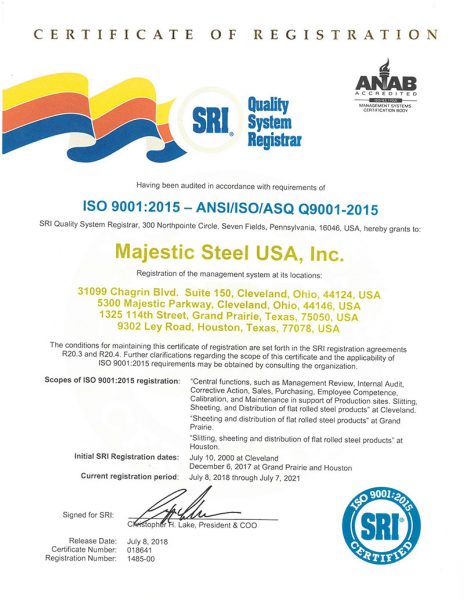Market Update | April 5, 2023
DOMESTIC MILLS RAISE PRICES FOR 9TH TIME SINCE THANKSGIVING
Cleveland Cliffs announced another price increase this week, marking the ninth increase of this cycle. Cliffs raised pricing another $100/t for all flat rolled products and set minimum HRC at $1,300/t ($65.00/cwt).
Input Costs
After climbing the previous two weeks, zinc pricing fell over the last week.
-
-
Zinc pricing came in at $1.28/lb this week, down from last week and at its lowest level since early November.
-
After the run up over the previous three months, spot iron ore pricing has remained steady over the past couple of weeks.
-
- Spot iron ore pricing is currently at $128.50/mt, down slightly from last week but up nearly 3% from last month and up 16.5% over the last 90 days.
- The decline in pricing was due to higher shipments, weaker than expected steel demand, and lingering concerns about the government taking actions against hoarding and speculative activities.
A wave of new supply, combined with a weaker demand environment has helped to push coking coal pricing lower as of late.
-
- Coking coal pricing currently sits at $292/mt, down 7.9% from last week and down 20.7% from a month ago.
Oil pricing surged this week after the OPEC+ announced a cut to production, which was a surprising move after previously stating that they would keep production flat.
-
- The 1 million barrel/day cut could push pricing back to $100 by summer, a price last seen in June.
Supply
U.S. raw steel production slipped slightly last week, now down for the second consecutive week.
-
- U.S. steelmakers produced 1.658 million tons at an 74.2% utilization rate.
- This was the lowest weekly output since mid-February and YTD production is down 4.1% compared to the same time last year.
Preliminary March import licenses, (27 days), showed carbon flat rolled imports are up 5.8% from the same time in February.
-
- Coated import licenses are up as well from February, as the daily rate in March is up 4.5%.
DEMAND
After climbing in January, total construction spending slipped in February.
-
-
February spending came in at a $1.844 trillion rate, down 0.1% from January but was up 5.2% from the $1.753 trillion rate in February 2022.
-
Spending has now increased, on a year-over-year basis, for forty-five consecutive months.
- While non-residential spending continued to climb, the sharper drop in residential spending pulled overall spending lower.
- Non-residential spending increased 0.4% from January and is now at a new all-time high.
- Residential spending slipped for the ninth consecutive month and is at its lowest rate since December 2021.
- Non-residential spending now accounts for 53.3% of the total spend, the highest percentage since November 2020.
-
U.S. light vehicle sales increased for the second consecutive month in March, as the daily sales pace increased to its highest level since May 2021.
-
- U.S. light vehicle sales totaled 1.366 million units in March, up 19.3% from February and up 8.5% from 1.258 million units in March 2022.
- This is the eighth consecutive month in which sales have increased on a year-over-year basis.
- Both sales of cars and light trucks saw strong gains in March, climbing 24.9% and 17.4%, respectively.
- Year-to-date light vehicle sales are now up 7.8% compared to the same timeframe last year.
Despite the recent rebound in sales, the recovery from domestic production has helped light vehicle inventory replenish over the last few months.
-
-
U.S. light vehicle inventory totaled 1.841 million units, up 5.9% from February and up 49.5% from March 2022.
-
Light vehicle inventory has now increased for the eighth consecutive month and is at its highest level since April 2021.
-
The current inventory, when combined with March’s sales pace, equates to 36 days of supply.
- This is flat from February and remains well below the long-run average of 65 days of supply.
-
Economic activity from the manufacturing sector continued to contract in March, now down for the fifth consecutive month.
-
-
The ISM Manufacturing Index came in at 46.3, down from 47.7 in February and 58.6 in February 2022.
-
Any reading below 50.0 indicates a contraction in activity, while any reading over 50.0 indicates expansion.
-
While the new orders and production components both continue to contract, the production component contracted at a slower rate than in February.
-
The new order and production components came in at 44.3 and 47.8, respectively.
-
The rate at which the backlog of orders is contracting accelerated in March, as the component slid from 45.1 in February to 43.9 in March.
-
This material, information and analyses (the “Content”) may include certain statements, estimates and projections prepared with respect to, among other things, historical data and anticipated performance. Content may reflect various assumptions by Majestic Steel USA, Inc. concerning anticipated results that are inherently subject to significant economic, competitive and other uncertainties and contingencies and have been included for illustrative purposes. Content is provided AS-IS.

